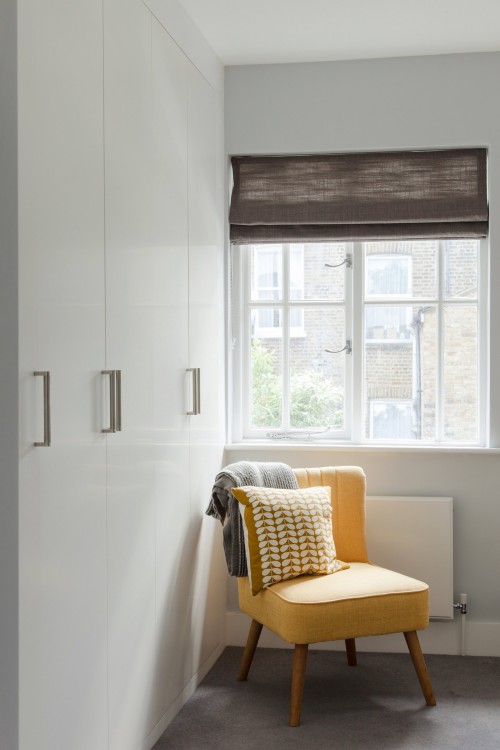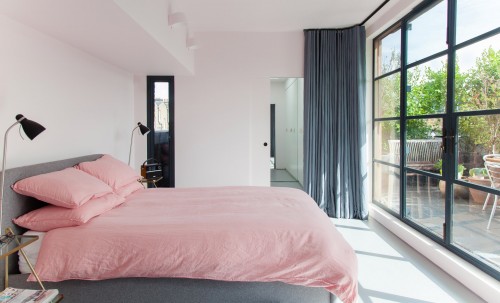The Womb - Bedroom interior design tips, from an architect's perspective
23 June 2021 by Simon Drayson
Old browser alert! We have detected you are using a pretty old browser. This website uses cool features that can't be supported by your browser.
If we let you see the website it would look all weird and broken, nobody wants that!
Update your browser!23 June 2021 by Simon Drayson
For many of us, this past year has been as much about looking backwards as it has about looking forward. During lockdown we both took the opportunity to revisit our decade-old academic work in order to help define our mission. For me this including rereading my thesis Sameness, which set out to identify a common architecture of essentiality, by exploring my former two-up-two-down Victorian terraced house (bread and butter for architects up and down the country).
The starting point when designing a bedroom should unsurprisingly be the bed, which should have at least 600mm clear access on all three sides. This will dictate what size bed you can comfortable accommodate in the space available (framed beds and headboards take up additional room, so you should avoid these in smaller spaces) and how much you have left for loose furniture (less expensive, more wastage) or fitted joinery (more expensive, less – often zero! – wastage). Wardrobes and chests of drawers are typically 600mm and 500mm deep respectively, with anything shallower have limited use and limiting your options for storage. If you have the headroom available, consider adding ‘top boxes’ to wardrobes to give you additional seasonal storage, for bulky items like suitcases and chunky winter jumpers in the summer. One trick we use is to take off-the-shelf IKEA wardrobes and disguise them as bespoke cabinetry, by constructed plasterboard sides and tops, and running the skirting board past the undersized standard plinth. If - like us - you like sleeping in the pitch black, you will need to think about window dressings right from the outset of the design process: combining blinds and curtains to achieve maximum impact whilst giving you varying degrees of privacy during the day. An upholstered wall-mounted headboard creates a focal point behind the bed without taking up additional floor area.

Your bedroom will most likely have two atmospheres that you will need to consider when designing the lighting: the first, dimmer light for reading and relaxing; the second, brighter light for dressing and cleaning (oh joy!). This can be achieved through a combination of ceiling, wall, floor and table lamps, which can be switched in a way that suits your waking and sleeping patterns. A really simple move is to adopt ‘hotel style’ switching, whereby the ceiling and walls lights are controlled from the bedside table, meaning you do not have to get out of bed to turn it off, with floor and table lamps also switchable from the door. To reduce bedside clutter, you could have a plug socket with an integral USB charger installed, a no brainer really! Think about other bedroom or dressing room activities too when planning your power layout, for example hiding a socket for your hairdryer inside wardrobes or chests of drawers. There is evidence to suggest that your bedroom should be cooler than the other rooms in your house to ensure a good night’s sleep; make sure that your radiators are fitted with thermostatic controls – or that your underfloor heating is installed on a separate zone – so that you can achieve this without affecting other rooms.

Whilst carpeted floors may have gone out of fashion in recent years, there is still a good case for having carpets in a bedroom, or at the very least rugs laid over hard floors like timber. When choosing a carpet, colour and patten aside, there are other factors, first and foremost cost. At the cheaper end are synthetic fibres such as polypropylene, with natural fibres such as wool at the pricier end; generally speaking, the former will offer more in terms of stain resistance but tend to wear out quicker, whereas the latter will last longer but are more prone to staining. Natural fibres are also prone to mould, mildew and moths. A good alternative to wool are plant-based materials including coir, jute, seagrass and sisal, which whilst not as soft underfoot add texture and interest. A carpet’s individual fibres (or ‘pile’) can either be looped or cut during manufacture which affects their appearance, with woven carpet – including Axminster and Wilton – offering higher quality, than the more popular tufted carpets. Given that bedrooms are often less frequented by visitors than other rooms, they can be suitable for wallpaper which changes the acoustics and ambience; this can also present an opportunity to use a pattern that is means something to you, perhaps taking riskier design choices than you would in the more public parts of your home.
